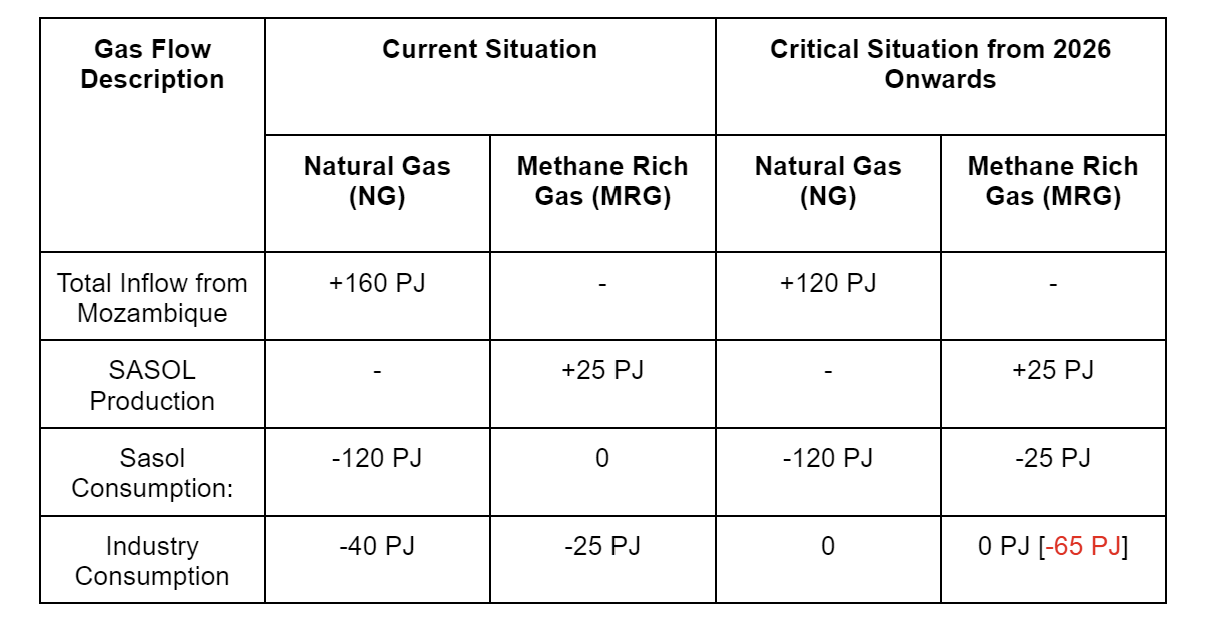SA’s gas crisis
Mantashe needs to urgently procure Gas-to-Power and approve Rompco-Lilly Bypass
Originally Published at Independent Online
South Africa currently depends on importing approximately 160 Peta Joules (PJ) of natural gas from the Gasfields in Pande-Temane, Mozambique. Facilitating this import is an extensive 856-kilometer pipeline called Rompco, establishing a vital link to SASOL’s Secunda plant. Within the total of 160 PJ of inflow, SASOL directly utilizes 110 PJ, while the remaining 50 PJ is allocated for industrial use. Notably, SASOL extends its contribution to the gas supply by allocating an additional 25 PJ Methane Rich Gas (MRG) to customers in Witbank and Durban. The transportation of the latter is accomplished through Transnet's pipeline, named Lily, that flows from Secunda to Richards Bay.
This natural gas infrastructure holds importance in supporting diverse factories across the Gauteng, Mpumalanga, and KwaZulu Natal regions. These areas are home to a multitude of heavy industries, including aluminum smelters, tiling, mining, brickmaking, paper production, steel manufacturing, and various other sectors crucial to the economy. At present, these industries rely solely on natural gas, lacking any alternative source of energy
According to Jaco Human, Executive Director of the Industrial Gas Users Association of Southern Africa, the nation is presently facing a significant gas crisis, a challenge that, if successfully addressed, could simultaneously assist in mitigating the persistent issue of load shedding. The origins of this crisis date back several years, with warnings from 2018 signaling that SASOL's production had reached a peak in Mozambique.
While the well is expected to continue generating volumes until 2038, it has become evident that the falling reserves will not be sufficient to meet the demand downstream from SASOL’s facility. This shortfall is exacerbated by an expected 10% annual drop in output from the gasfields. In an effort to anticipate the impending decline in production, SASOL invested strategically in new well drills around 2016 at its Mozambique facility in Pande-Temane. Regrettably, these exploration endeavors yielded no success, intensifying the urgency of the situation.
In August 2023, SASOL dropped the bombshell, announcing its inability to serve downstream customers after June 2026. This decision stems from a strategic reduction in MRG output to generate internal electricity, acting as a bridge until 2028 when the company foresees running out of sufficient natural gas for its own consumption. This revelation, openly acknowledged by SASOL, not only imperils South Africa's heavy industry but also triggers concerns about Sasol itself, with a R36 billion financial impairment that could jeopardize the entire industrial economy. Sasol’s earnings before interest and tax fell by 65% to R21.5-billion year-on-year in 2023, partly because of the impairment of assets.
As the table below shows South Africa will face an imminent shortage of 65PJ for industrial consumption from 2026 onwards.
The natural gas, which primarily consists of methane, plays a pivotal role in industrial heating processes. The urgency of the gas crisis raises concerns about the potential closure of South Africa’s heavy industries, as they may be forced to cease operations due to the shortage of this critical energy resource.
The most efficient solution to address the shortage is for the South African government to procure at least 2GW Gas-to-Power (GTP) from Mozambique. Sufficient transmission line capacity already exists for this solution. A 2GW GTP initiative would generate sufficient volumes for TotalEnergies, leveraging its operations in Mozambique to support the injection of gas into the pipeline, as indicated in the map below.
In addition to serving the customers downstream, Rompco will be incentivised to invest into the Rompco-Lilly Bypass that will take approximately 3 years to build.
It is recommended that the South African government enter into a 15-20-year Power Purchase Agreement to ensure the viability of the proposed volumes. A 5 Megaton per annum (MPTA) Matola terminal could readily meet the industry's gas requirements (estimated at 100 PJ) and provide 2 GW Combined Cycle Gas Turbine (CCGT) additional generation capacity for Eskom.
The site at Matola is already shovel ready, it is the least constrained solution.
Therefore, by addressing the gas crisis, the SA government could simultaneously eliminate two stages of load shedding. A prompt solution lies in a simple phone call to engage with TotalEnergies, Rompco and Mozambique. The Department of Minerals and Energy (DMRE) simply has to make a commitment to procure 2GW GTP and agree to the construction of the Lilly-Rompco bypass.
All Minister Gwede Mantashe needs to do is issue the instruction and pick up the phone to make a few calls so that our heavy industries can be saved from collapsing!




